
在上一篇文章中,我们提到将通过「缓存」机制来解决 computed 在访问时重复执行的问题。
在 Vue 3 的源码里,computed 是靠一个「脏值标记(dirty flag)」来判断是否需要重新计算的。
Computed 缓存解决方案
核心逻辑
在 computed 中记录脏标记:当脏标记为 true,才需要进行更新;当脏标记为 false,则表示可以走缓存。
jsx
class ComputedRefImpl implements Dependency, Sub {
...
...
tracking = false
// 计算属性是否需要重新计算;为 true 时重新计算
dirty = true
...
...
get value() {
if (this.dirty) {
this.update()
}
...
...
}
update() {
...
...
try {
this._value = this.fn()
// update 执行完成后,将 dirty 改为 false,表示已缓存
this.dirty = false
} finally {
endTrack(this)
setActiveSub(prevSub)
}
}
}回到示例,现在已经有了缓存,只执行两次。但我们又发现另一个问题:如果你把 index.html 设置为以下内容:
xml
<body>
<div id="app"></div>
<script type="module">
// import { ref, computed, effect } from '../../../node_modules/vue/dist/vue.esm-browser.js'
import { ref, computed, effect } from '../dist/reactivity.esm.js'
const count = ref(0)
const c = computed(() => {
console.log('computed')
return count.value + 1
})
// effect(() => {
// console.log(c.value)
// })
console.log(c.value)
count.value = 1
</script>
</body>你会发现 count.value 数值变更之后,它还是访问了 computed;但当依赖 computed 的值被变更时,我们不一定会当场访问 computed。
看一下官方实现,count.value 数值变更后,如果没有访问 computed,computed 并不会立刻求值。

而我们的版本会再访问一次 computed:

遇到这种情况怎么处理?可以仅做脏标记,等下次 computed 被 effect 访问时再执行更新。
perl
// system.ts
...
...
export function processComputedUpdate(sub) {
// 只有存在 sub.subs(effect 链表的头节点)时,才进行更新与传播
if (sub.subs) {
sub.update()
propagate(sub.subs)
}
}
export function propagate(subs) {
let link = subs
const queuedEffect = []
while (link) {
const sub = link.sub
if (!sub.tracking) {
if ('update' in sub) {
// 被 effect 再次访问,计算属性需要重新计算:改脏标记
sub.dirty = true
processComputedUpdate(sub)
} else {
queuedEffect.push(sub)
}
}
link = link.nextSub
}
queuedEffect.forEach(effect => effect.notify())
}
...
...这样即可解决缓存时机的问题。但我们又发现了新的问题。
Effect 重复执行问题
xml
<body>
<div id="app"></div>
<script type="module">
// import { ref, computed, effect } from '../../../node_modules/vue/dist/vue.esm-browser.js'
import { ref, computed, effect } from '../dist/reactivity.esm.js'
const count = ref(0)
const c = computed(() => {
console.log('computed')
return count.value * 0
})
effect(() => {
console.log(c.value)
})
setTimeout(() => {
count.value = 1
}, 1000)
</script>
</body>
现在我们看到,computed 执行了两次,这没问题;但 effect 的输出值没有变化,它却也执行了两次。如果数值没变,应只执行一次。
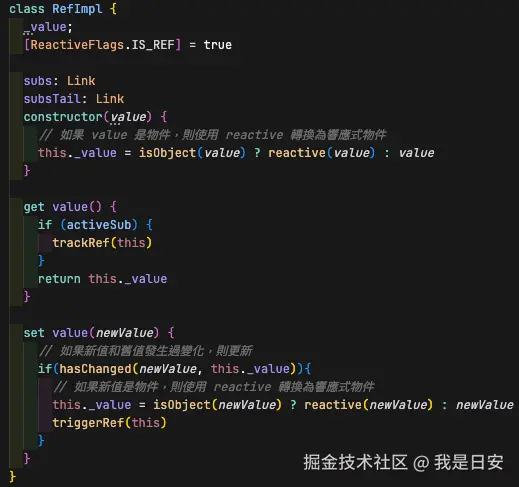
回顾我们在 Ref 的实现:触发更新时,只有新旧值不相同时才会继续通知订阅者。在这里也用同样做法。
kotlin
// computed.ts
import { hasChanged } from '@vue/shared'
...
...
class ComputedRefImpl implements Dependency, Sub {
...
...
update() {
...
...
try {
// 更新前的值
const oldValue = this._value
// 计算后的新值
this._value = this.fn()
this.dirty = false
// 只有当新旧值不同才返回 true
return hasChanged(oldValue, this._value)
} finally {
endTrack(this)
setActiveSub(prevSub)
}
}
}保存更新前的值,用 hasChanged 判断数值是否改变,并用 update 的返回值来控制传播:
vbscript
// system.ts
export function processComputedUpdate(sub) {
// update 返回 true 表示数值发生变化,才继续向下触发 effect
if (sub.subs && sub.update()) {
propagate(sub.subs)
}
}得到期望结果:computed 执行两次、effect 仅执行一次。

看起来问题解决了,但这其实只是片面的 。因为当 effect 在一次运行中多次访问相同依赖 时,仍会重复触发。
Effect 访问相同依赖重复触发问题
xml
<body>
<div id="app"></div>
<script type="module">
// import { ref, computed, effect } from '../../../node_modules/vue/dist/vue.esm-browser.js'
import { ref, computed, effect } from '../dist/reactivity.esm.js'
const count = ref(0)
effect(() => {
console.count('effect')
console.log(count.value)
count.value
})
setTimeout(() => {
count.value = 1
}, 1000)
</script>
</body>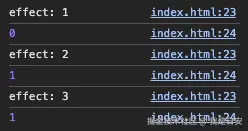
可以看到触发了三次。如果你查看 count:
javascript
effect(() => {
console.count('effect')
console.log(count.value)
count.value
})
console.log(count)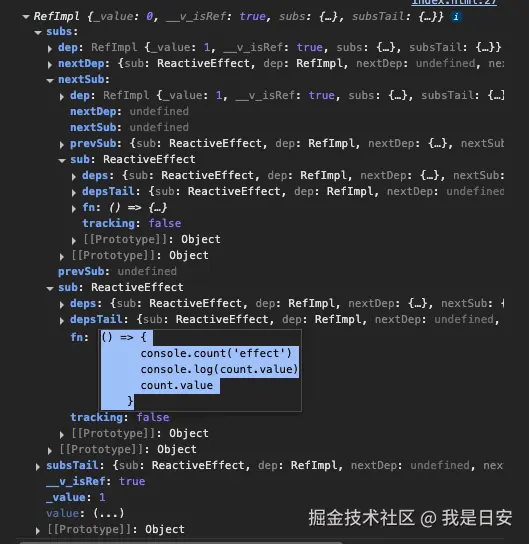
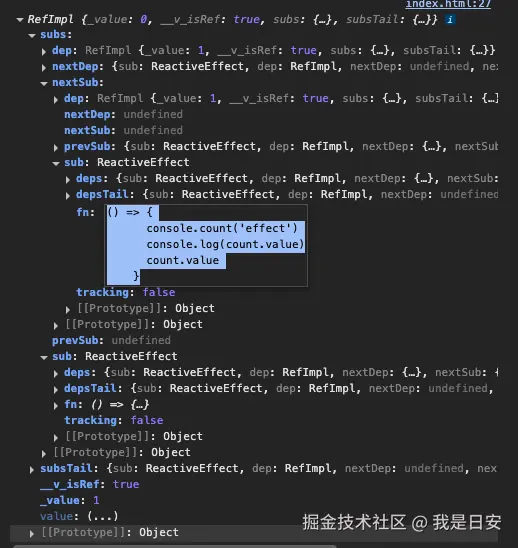
会发现它把同一个依赖收集了两次。如何解决?
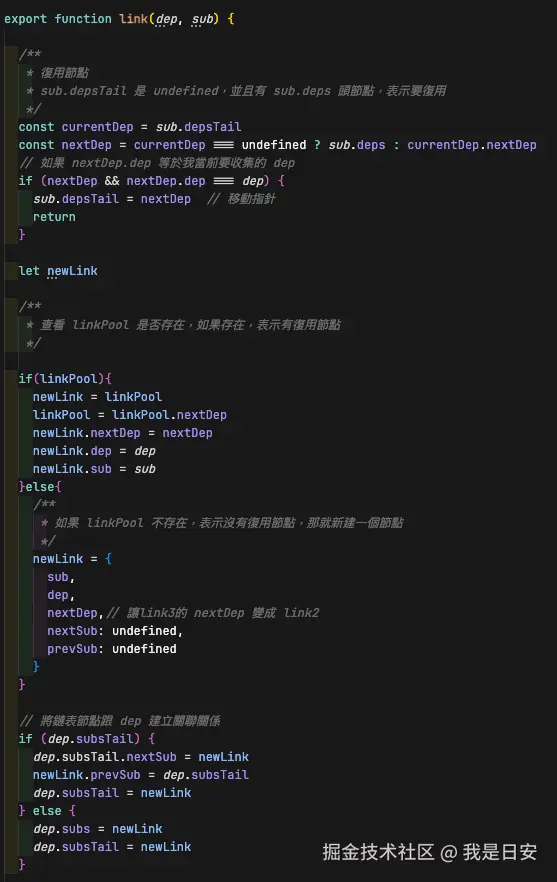
在源码中,link 函数里,每次建立关联之前都会遍历链表,确认是否已经建立过关联。
方法一:在 link 函数判断是否已建立关联
perl
export function link(dep, sub) {
/**
* 复用节点
* sub.depsTail 为 undefined 且 sub.deps 存在时,尝试复用
*/
const currentDep = sub.depsTail
const nextDep = currentDep === undefined ? sub.deps : currentDep.nextDep
// 如果 nextDep.dep 等于当前要收集的 dep,则只移动指针
if (nextDep && nextDep.dep === dep) {
sub.depsTail = nextDep // 移动指针
return
}
/**
* 若 dep 与 sub 之间已建立过关联,则直接返回,避免重复收集
*/
let existingLink = sub.deps
while (existingLink) {
if (existingLink.dep === dep) {
// 已经建立过关联,直接返回
return
}
existingLink = existingLink.nextDep
}
...
...
}要点:
- 先尝试"复用节点",再做"是否已建立过依赖"的遍历检查;
- 如果把"已建立依赖检查"放在前面直接 return,可能导致
depsTail长期保持undefined,从而被错误清理。
方法二:重构脏标记(推荐更简洁)
换一种更简单的思路:不去管是否重复建立依赖 ,而是确保 effect 在一次更新周期内只入队执行一次。做法是对 effect 加统一的脏标记控制。
arduino
// effect.ts
export class ReactiveEffect {
...
...
dirty = true // 是否需要重新计算(用于控制入队)
...
}在触发更新与结束追踪时,加入脏标记逻辑:
perl
// system.ts
export function propagate(subs) {
...
...
// 仅当不在执行中,且目前是"干净状态"(dirty=false)时,才入队
if (!sub.tracking && !sub.dirty) {
// 入队前先设置为"脏"(避免同一轮事件循环被重复入队)
sub.dirty = true
if ('update' in sub) {
processComputedUpdate(sub)
} else {
queuedEffect.push(sub)
}
}
...
...
}
export function endTrack(sub) {
sub.tracking = false // 执行结束,取消执行中标记
const depsTail = sub.depsTail
sub.dirty = false // 本次 fn 执行完毕,复位为"干净"
...
...
}这样,如果多个依赖同时触发同一个 effect ,它也只会被加入队列一次:因为一旦 dirty 被设为 true,后续 !sub.dirty 就为 false,不会再次入队。endTrack 中把 dirty 复位为 false,表示该 effect 已经完成了本轮的最新计算。
同时,删除 computed.ts 中对脏标记的重复初始化,避免两边打架:
kotlin
// computed.ts
..
..
update() {
...
...
try {
const oldValue = this._value
this._value = this.fn()
this.dirty = false // 移除重复的初始化逻辑,统一交给 endTrack 处理
return hasChanged(oldValue, this._value)
} finally {
endTrack(this)
setActiveSub(prevSub)
}
}
..
..
脏标记的判断与运行流程
- 初始化 :一个
effect在执行完毕后,dirty会被设为false,表示「当前是最新状态,不需要再次执行」。 - 触发更新 :当依赖变更时,
propagate会检查该effect是否为dirty: false。 - 入队前 :只有当
dirty为false时,才会将其先置为true,然后再把effect加入待执行队列。 - 防重复 :由于入队前已设为
true,同一事件循环中即便有多个依赖触发,也只会入队一次,避免不必要的重复执行。
想了解更多 Vue 的相关知识,抖音、B站搜索我师父「远方os」,一起跟日安当同学。